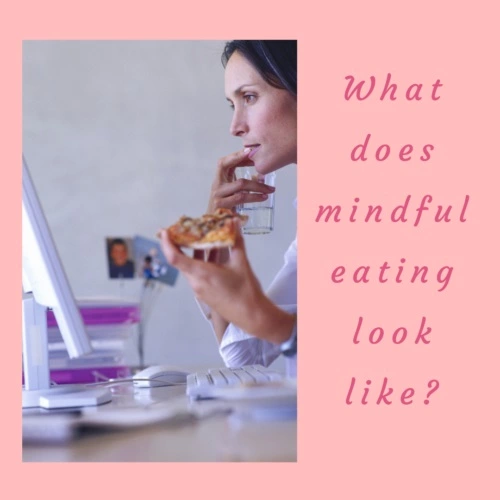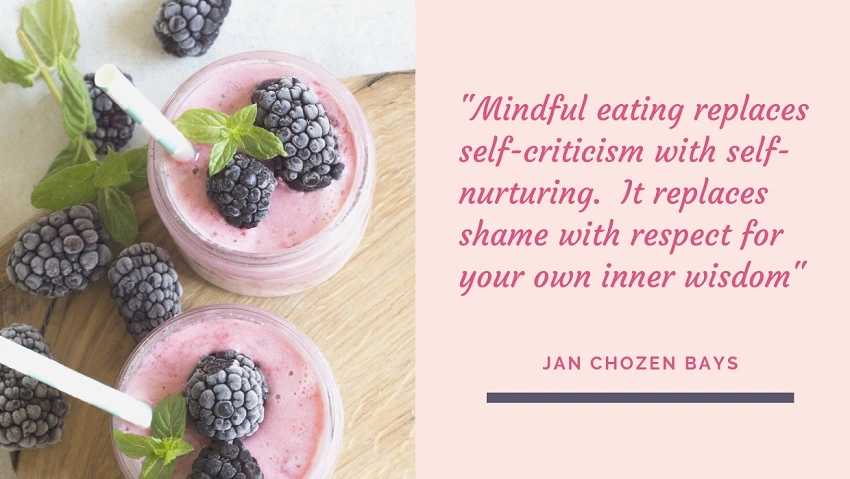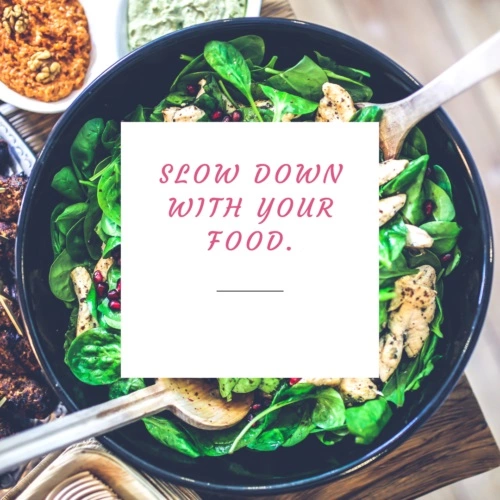
Mindfulness and Food
Mindful eating is a critical topic to talk about so we can get to the core reasons why we binge or overeat. Mindfulness might conjure up images of a lone monk perched on a hill somewhere deep in meditation chanting ommmmmm. So why would I be talking about mindfulness and eating in the same blog post? Well, here goes…..
Mindfulness is not a temporary state while we meditate. It is not a fragment of an experience that disappears for the rest of the day after our yoga practice has ended. It is a way of living, a way of being that we can step into at any time, which is back, fully, into any present moment.
This process involves becoming aware of our internal bodily sensations, thoughts and emotions, without any judgement and observing with curiosity. So, mindful eating is simply using this process around our food.

Mindfulness Explained Simply with “The Raisin Exercise”
An interesting mindfulness exercise to illustrate mindfulness is called “The Raisin Exercise” (as explored by mindfulness guru Jon Kabat Zinn). You don’t have to love raisins to do the exercise, it can be done with any type of food, like nuts for fruit for instance.
The exercise involves looking at a raisin as if you had never seen it before. How does it look ? How does it feel? What is the texture like? Is it hard or soft? What is the smell? How does it taste? This exercise is interesting as it moves our focus deeply and fully onto one thing.
Becoming fully present in that moment of observing and tasting the rasin, you become beyond worries and are fully present. The benefits of mindfulness are far-reaching and include increased focus, heightened energy levels, decreased stress, as well as a myriad of health benefits.
Sounds Easy! So where do we get it so wrong?
It seems easy enough (mindfulness) except for the annoying fact that we all so often veer from the present moment, worrying about what happened yesterday and what will happen tomorrow. Our monkey mind, at times, wants to be anywhere but the present moment. This is what makes mindfulness in day-to-day life challenging!
So how does mindfulness help with overeating, binging or cravings I hear you ask? Well, let’s first look at how we do the opposite – mindlessly eat.
Chances are for most of us, when we are tired, hungry, stressed or feeling emotional we are easily lured in by tasty food and our dietary goals get thrown out the window. Or even worse than this, you continue to eat despite being horribly full ? I think most of us have been there. Or eating breakfast while simultaneously scrolling Facebook and Instagram? Or for the mums out there, frantically shoving food in our mouth as we make the kid’s dinner?

So what does mindful eating look like?
For me, I believe there is an overlooked psychological component. A critical way we make changes to our eating patterns is getting to the emotional reasons of why we eat, and mindfulness provides a way to create space to lovingly observe. Here are 5 practical things we can do to practice mindful eating that will empower us!

5 Mindful Eating Practices
1. Lovingly observe your thoughts and feelings before, during and after a binge
Mindful eating can help us become aware of the emotions, thoughts and bodily sensations we experience when we binge or overeat. Imagine yourself experiencing a night binge for instance. Having one piece of chocolate, and before you know it, the entire block is gone (whoops).
It is actually in these times we need to practice mindful eating. It is in these times we can find compassion towards ourselves. We can become curious (in a self-loving way) about why we ate the entire block of chocolate in one sitting.
Or ask yourself these questions…
- What thoughts or feelings triggered me to eat so much chocolate?
- What was I feeling right before I first ate the chocolate?
- Did I feel any sensations in my body? Any tension? Where abouts? Heart? Stomach ?
- Did I feel anxious?
- What did I feel after I finished the block?
This will bring us back to the physical body.
Cultivating mindfulness in the rough times of a binge is empowering. We are trying to create awareness about what is happening, so it won’t have such a strong grip on us. When we identify the emotional triggers of the overeating or binging we can discover the core issues or the “why” – meaning we can make a plan for next time.

2. Slow Down (as much as you can)
The benefits of eating slower are vast. They include better digestion, increased hydration and easier weight loss. Slow eating allows the body and brain to become synced, providing time for your body to catch up to your brain that signals that you are full (this takes 20 minutes from the beginning of your meal).
So essentially, eating slower allows you only eat what your body requires. Simple strategies to incorporate this include chewing each mouthful 15-20 times (or whatever works for you), sitting down to eat and taking rests between mouthfuls.

3. Develop healthy eating practices
Do you eat at a table with a plate and utensils? I know it seems ridiculous to ask this, but one way for many of us eat is raiding cupboards or looking aimlessly in the fridge for food at any given time. When we take the time to become conscious of where and the times we eat, we will then automatically think about what we are eating and become more mindful.
4. Stop multitasking
Eating while we do a million other things is not mindful. If we are eating and doing something else, we can not focus on how full we feel. We can not focus on what our body is telling us. Not only this, it becomes difficult to observe any emotions that might have come up in relation to the food (stress, sadness etc). Try just one meal without screens and see how you connect more into your body, breath, emotions, thoughts and the food itself.
5. Know when your body signals hunger – what is your sign?
Knowing your own sign of hunger is important. Sometimes we think we are hungry but we are actually sad, stressed, frustrated, bored – or even thirsty for water. When you go to prepare a meal or snack are you actually hungry (in your stomach) or are you responding to an emotional need? This is mindfulness.
This is stopping, breathing and checking in with yourself and observing thoughts and feelings and really connecting to what your body is telling you.
I’m Overwhelmed!……Where do I Start?
Mindfulness might not be the answer to all of our problems but it is a key component in nourishing many aspects in our lives! Life can be chaotic so I suggest starting small and creating habit that way…
- Can’t sit down and eat for all meals? Make a goal of doing it once per day.
- Don’t have time to eat without simultaneously answering emails? Try just having your morning smoothie without distractions at first
- Struggle to observe during a binge about what emotions or sensations you are feeling (as you are in a emotional state)? A good start is to reflect on them after the fact, and perhaps write them down.
Download the free Mindful Eating guide to create a deeper awarness of why, how and when you eat and to understand your relationship with food on a deeper level.

Start small and with what is possible within the realm of your own personal situation. Let’s make a shift from distracted eating and become more mindful. I promise you will become more intuitive with food, feel more empowered around eating, whilst have more energy for your day.
What Else?
- Mindfulness can be cultivated through various meditation practices. Check out these FREE meditations from the Centre of Mindful Eating.
- For those who snack while cooking check out this blog post that gives suggestions to stop this from happening
- Also check out my favourite body positive podcasts to ditch dieting- there are some interesting ones about emotional eating and how to feel your feelings.
References
Kabat Zinn, J. (2005). Coming to Our Senses. New York: Hyperion



